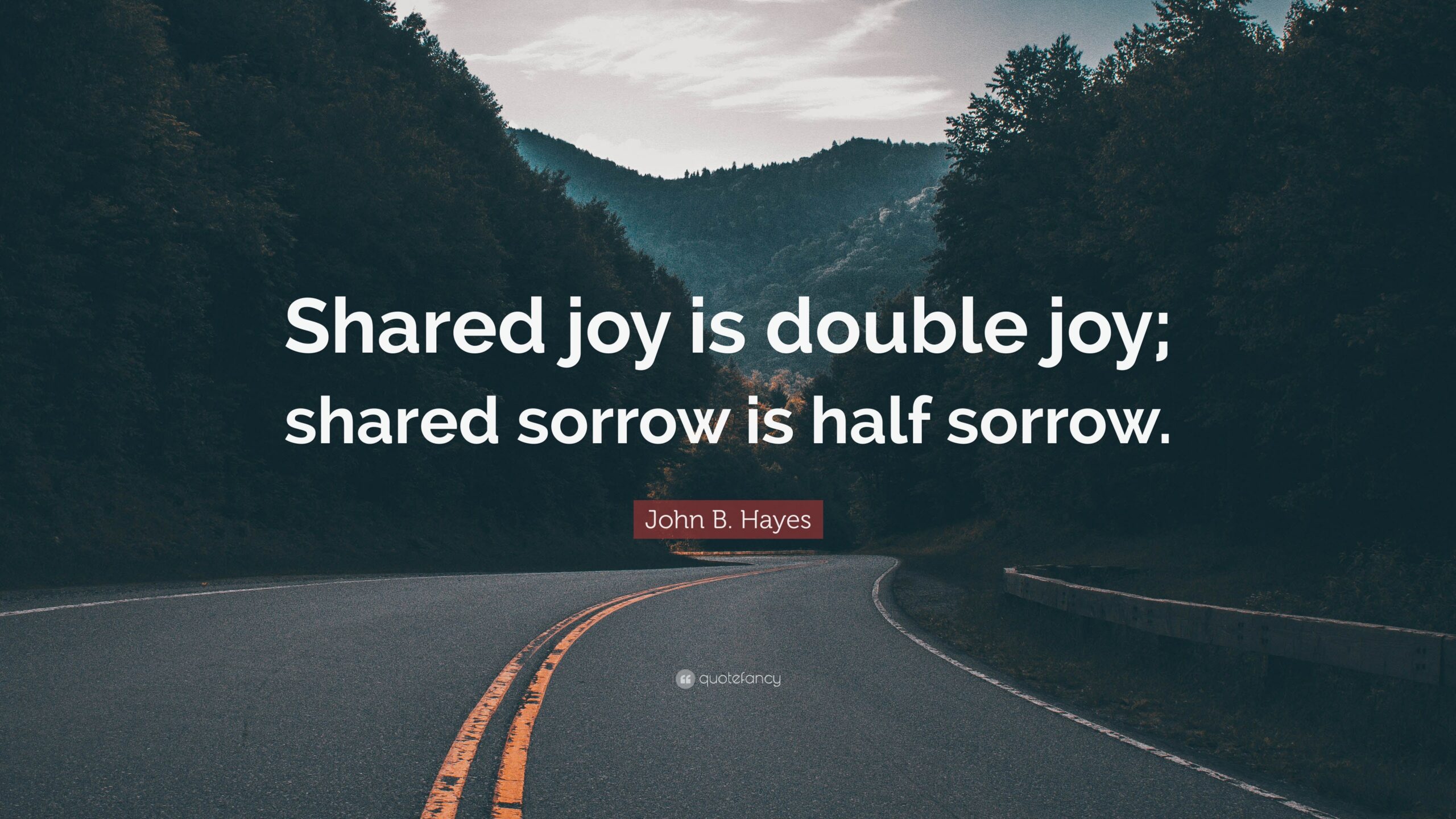Understanding Joy: The Concept of Shared Happiness
Joy is often viewed as a fleeting emotion, a state that arises from positive experiences, achievements, or connections. However, the concept of shared shared joy is a double joy; shared sorrow is tymoff happiness reveals that joy becomes more profound when it is experienced collectively. Psychological and sociological studies indicate that individuals report higher levels of satisfaction when they share moments of happiness with others. This suggests that joy is not just an individual phenomenon but also a communal one, where the very act of sharing enhances the emotional experience.
One reason for this phenomenon is that shared joy fosters deeper social connections. When happiness is shared, it creates a bond between individuals that can strengthen relationships. For instance, celebrating a friend’s success or experiencing a joyous event together can reinforce the ties that bind people, enhancing feelings of trust and intimacy. Research supports this notion, showing that individuals who engage in shared joyous activities are more likely to report increased feelings of belongingness and community.
Moreover, personal anecdotes often illustrate the power of shared happiness. Consider a group of friends gathering to celebrate a milestone. Each laughter, cheer, and shared story amplifies the joyful atmosphere, creating a collective memory that shared joy is a double joy; shared sorrow is tymoff transcends the individual experiences of the participants. This communal joy not only enriches the lives of those involved but also contributes to a greater sense of life satisfaction overall. As such, rituals and traditions that involve shared celebrations—be it birthdays, holidays, or community events—serve as vital cultural expressions of joy, reinforcing the importance of connection during these moments.
In essence, shared happiness cultivates an environment where individuals can thrive together, promoting mental well-being and enhancing community strength. As joy is experienced within a social context, it transforms into an enduring source of satisfaction, shaping the lives of those who embrace it.
The Science of Happiness: Why Shared Joy Matters
The understanding of happiness has been enhanced by various scientific studies that highlight the significance of shared joyful experiences. The release of neurotransmitters such as oxytocin and dopamine plays a crucial role in reinforcing social bonds during these moments. Oxytocin, often referred to as the “love hormone,” is released when individuals engage in positive social interactions, promoting feelings of trust and connection. Research indicates that when people share joyful experiences, the heightened levels of oxytocin contribute to stronger emotional ties, fostering a sense of belonging. As a result, these shared moments not only create happiness but also enhance relational intimacy.
Moreover, dopamine, another neurotransmitter, is associated with pleasure and reward. Experiencing joy collectively can amplify dopamine responses, shared joy is a double joy; shared sorrow is tymoff making the feelings of happiness more intense and long-lasting. The physiological responses elicited from these shared experiences are instrumental in reinforcing the happiness that individuals feel, laying the groundwork for a more interconnected society.
Culturally, many societies have rituals and traditions centered around collective joy. For instance, festivals and communal gatherings serve as platforms for people to celebrate milestones and achievements together, creating an environment where shared happiness thrives. These cultural practices highlight the value placed on social interactions and the essential role they play in individual well-being. Countries such as India and Brazil, known for their vibrant festivities, exemplify how communal joy fosters a sense of community that significantly enhances the overall quality of life.
The implications of shared joy extend beyond individual experiences; they contribute to societal cohesion and overall mental health. As individuals engage in these joyful interactions, they cultivate resilience and support networks that are vital in challenging times. Ultimately, understanding the science behind shared happiness reveals its importance not just for personal enrichment, but also for societal well-being.
Navigating Sorrow: The Comfort of Shared Grief

Sorrow and grief are profoundly personal experiences, yet they can be significantly alleviated through shared emotional connections. The act of shared joy is a double joy; shared sorrow is tymoff expressing pain to others can serve as a form of therapeutic release, a concept often described as a ‘tymoof.’ When individuals come together in times of loss, they find solace in recognizing that they are not alone in their suffering. This communal aspect of grief offers a powerful avenue for healing, allowing individuals to process their emotions in a nurturing environment.
Engaging in meaningful conversations about sorrow can yield psychological benefits that are instrumental in coping with loss. The cathartic effects of sharing grief facilitate the expression of intense emotions, which, if suppressed, can lead to prolonged suffering and mental health issues. Sharing experiences in support groups, for example, encourages participants to articulate their feelings, fostering a sense of understanding and validation among peers. This environment, characterized by empathy and compassion, can strengthen bonds and create a sense of belonging, essential components for healing.
Moreover, the role of community support cannot be overstated during such times of bereavement. Communities often rally together to provide comfort, whether through emotional backing or practical assistance. Participating in collective mourning rituals or commemorative gatherings reinforces the acknowledgment of shared loss, enabling individuals to feel supported. The dialogues generated within these groups often invite personal stories that enrich the healing process while diminishing the isolating effects of grief.
In this supportive atmosphere, mutual empathy shared joy is a double joy; shared sorrow is tymoff empowers individuals to embrace their grief, ultimately leading to a transformation in how they navigate sorrow. Understanding that sorrow is a universal experience can be profoundly validating. Through these connections, individuals are better equipped to confront and process their emotions, utilizing the support of others as a vital tool in their journey toward healing.
Building Connections Through Shared Experiences
Creating an environment that nurtures shared experiences of joy and sorrow is essential for fostering deeper connections among individuals. In both personal relationships and community settings, the level of emotional connections can significantly affect mental health and overall well-being. To cultivate such an environment, specific practices can be implemented that encourage individuals to share their feelings openly.
One effective method is storytelling. Sharing personal shared joy is a double joy; shared sorrow is tymoff stories allows individuals to express their joys and challenges in a relatable manner, fostering empathy and understanding among listeners. Encouraging this practice within a group can create a safe space where emotions are valued and validated, making it easier for individuals to resonate with one another’s experiences. As members of a community or workplace recount their stories, they can inspire others to share, creating a ripple effect of openness.
Active listening is another critical element in cultivating an emotionally inclusive space. By genuinely paying attention to what others say, individuals convey validation and respect, allowing for authentic connections. This practice fosters an atmosphere where people feel comfortable expressing both joy and sorrow without the fear of judgment. Training programs that emphasize the importance of listening skills could be implemented in workplaces and community groups to enhance this vital connection.
Embracing vulnerability also plays a crucial role in shared joy is a double joy; shared sorrow is tymoff building these connections. When individuals allow themselves to be vulnerable, whether by sharing a personal struggle or expressing joy, it encourages others to follow suit. This reciprocal sharing can lead to stronger bonds and a communal sense of support. To promote such an environment, workshops or support groups can be organized, focusing on building emotional resilience through shared experiences.
In conclusion, fostering an environment that encourages shared emotions through storytelling, active listening, and vulnerability can transform personal relationships, workplaces, and community settings into connected and empathetic spaces. By adopting these actionable strategies, individuals can create a culture where joy and sorrow are shared freely, promoting emotional health for everyone involved.

